
The Hunter 170 is a joint venture between Hunter Marine and JY sailboats, which combines simplicity and comfort with toughness and performance. The boat and rigging are set up to be as simple as possible, allowing the owner to rig the boat and go sailing very quickly. The mast is light and can be put up by one person, although it's easier with two. The jib is set up on a roller-furling system with the sheets led back to swivel blocks in the cockpit. The mainsail is simple as well, with only one line necessary for the outhaul and a main halyard that is easily accessible on the mast from the cockpit. I was told that reef points for the sail are an option, but our test boat came with only two settings for the main-either all the way up, or all the way down. The mainsheet is placed conveniently near the helmsperson to trim while driving, but the block swivels so it can be trimmed just as easily by the crew. This simplicity results in a clean and uncluttered cockpit, making movement about the boat very easy.
The standard version of the Hunter 170 has a centerboard that draws 4 feet, 6 inches when fully lowered. It is built with a counterweight so it doesn't require a 270-pound linebacker or a maze of blocks to pull it back up. Combined with the swing-up rudder, landing on the beach or parking on a sandbar is a breeze. With the centerboard up the boat draws only 6 inches. An added bonus is the open transom, which allows for easy access when swimming or boarding. Another option is a 2.5-horsepower outboard, but we decided to go on our test with sails alone. With a blue sky, and about 15 knots of breeze, it couldn't have been a more perfect day for sailing. When I met up with Eric Macklin of Hunter Yachts at the Miami Yacht Club to take the boat for a spin, Macklin had the boat on the trailer waiting in line with the mast already up at boat ramp, and within minutes of our arrival, we had the boat floating at the dock.
Macklin gave me a verbal tour of the boat, and as I got myself acclimated, we sailed out into the bay. The boat comes with a canvas-covered storage area in the bow and sheet bags mounted at the mast. This is an excellent place to keep gear, life jackets, coolers, or other stuff out of the way. As I leaned forward to take the dockline off the bow, I found the one thing that I didn't like about the boat: It was a long reach from the cockpit to the forward cleats, and the canvas cover doesn't support a person's weight when leaning forward. This minor awkwardness aside, the canvas can easily be removed by unsnapping it if you need to reach forward, which is what I did.
The Hunter 170 turned quickly through the wind, and I found that, although a stable boat, it is still sensitive to weight placement, and in a breeze, you definitely need to be on the high side.
After the third tack, Macklin said, "Uh, you don't have to duck. That's one of the best things about the set-up." Of course, he was right and I had to laugh at myself. Years of sailing Lightnings had taken its toll-I was unconsciously ducking my head through each tack, even though the boom was a good three feet above it. In addition to the generous headroom, the clean layout of the cockpit can easily accommodate six people. The contoured benches were also very comfortable as we sat back to enjoy the view of Miami from the bay.
Upwind in the puffs, the wind was strong enough that we had to play the sails to keep the boat under control. Had we not been pushing the boat hard, we probably would have rolled up the jib and sailed under main alone, since with the fractional rig, the main alone provides plenty of power in breezier situations. With the boat heeled, I found that Hunter had the foresight to incorporate a toerail down the center of the cockpit floor. Sailing hard upwind with my feet now firmly planted, I noticed that the boat did not have a heavy weather helm even when it was fully heeled over. I was able to turn the boat up and down with the flick of the arm.
We cracked off slightly onto a reach, and the boat took off. The wide beam provided plenty of stability. Our test boat did not come with the optional asymmetrical spinnaker, but this is an option I would recommend for the sailor looking for lots of fun off-the-wind. We tested the roller-furling jib, and I found that, as with everything else on this boat, it was very easy to use. The line used to roll up the sail is led back to the cockpit and conveniently located next to the cleat for the jib sheet on the starboard side. Macklin suggested that the jib is easier to roll up when sailing dead downwind. The technique also made for a tidier-looking furling jib.
The 170 is built using Hunter's Advanced Composite Process, known as ACP, which makes the boat light, durable, and virtually unsinkable. The technique begins with a weather-resistant polymer on the outside and a knitted fiberglass fabric on the inside. A urethane foam is then injected in between and the resulting sandwich heated and vacuum formed, making it extremely strong and solid. The process is actually environmentally friendly, since the plastic used in the construction is recyclable. In fact, scraps from the building process are recycled on-site at the factory.
The exterior plastic is scuff-resistant, which makes the boat easy to clean and maintain. According to Hunter Marine, since the layers are bonded together and not laminated, delamination isn't even a possibility.
The foam core is also very light so that the boat weighs only 480 pounds. For the skeptics out there, Hunter stands behind the product and puts its money where its marketing is-the hull has a five-year warranty.
The 170's solid construction and straightforward layout make it ideal not only for beginners, but also for more experienced sailors who want a fast, simple boat to take out just for fun. Hunter has taken great steps to ensure that the 170 has a wide appeal by balancing durability and performance for a high fun factor. As is the case with so many of it boats, the company seems to have found the right combination.

Also in Perry on Design
- Full Circle 30
- Tanton No. 309
- Dragonfly 40
- Wallyrocket 51
- Clubswan 28
Also from Robert H. Perry

Are Hunter Sailboats Any Good? (My Honest Experience)

There are a ton of different sailboat brands in the world today. Trying to decide which one is best, is no easy task. It comes down to a bit of fact and personal opinion, but that’s my opinion.
Hunter is a very well-known brand of sailboats. Hunter sailboats are a good boat depending on your needs and what you will be using your boat for primarily. They were designed as a more budget-friendly boat with all of the basic features needed for good coastal cruising.
The debate about whether a Hunter sailboat is good or not has been going on since the company started and there are a lot of pros and cons out there on the sailboat forums. This article is going to go over Hunters and cover as many of the pros and cons as possible. There will be facts and my personal opinion throughout this article. I just want to cover as much as possible so you will have the knowledge you need when considering a Hunter.

The History Of Hunter Sailboats
In the 1800s Henry Luhrs, a German immigrant, outfitted trading ships. He continued to work on boats his whole life and eventually passed the skills on to his grandson. His grandson was also named Henry and continued the family trade on the Jersey coast, building and repairing recreational and fishing boats. After a while, Henry and his sons started the Hunter Company in 1973 in Alachua, Florida, as a sailboat manufacturer.
Luhrs was the owner of the company, but the early boat designs were done by a man named John E. Cherubini. One of the most recognizable boats of the Hunter legacy is the Cherubini Hunter 30. In my opinion, this is a fantastic boat.
Towards the end of the 1980s, the company did run into trouble. Luhrs was not necessarily running the company at this time, he was out sailing the world and had let a board of management take over. The management team had started to run the company into the ground. They did this by only offering a 1-year warranty, poorly built boats, and terrible customer service for its customers. This would be sure to end any company. Luhrs, with fear his company would go under, decided to return immediately and address the issues at hand. He decided to do a whole restructuring of production and decided extending the warranty from one year to five years would be a good start. Luhrs also hired Canadian designer Rob Mazza in 1991 to take over the design and coordinate the production process. These many steps and others helped get the company back on track.
Hunter is responsible for several market innovations, including their trademark stainless steel cockpit arch and their use of the B&R rig. The B&R rig uses swept spreaders that are usually angled aft, together with “stays” running diagonally downward from the tip of the spreaders to the attachment of the next pair of spreaders to the mast or to the intersection of the mast with the deck, that facilitates a pre-bend of the mast (curving aft).
In 2012 Hunter Marine entered Chapter 11 bankruptcy. The company was sold in August 2012 to David E. Marlow, owner of Marlow Yachts and the name changed to Marlow-Hunter, LLC.
Marlow-Hunter continues to produce sailboats to this day and I must say….they are beautiful designs.
Before we start the debate about whether Hunter sailboats are good or not, let’s look at one or two of their better models.
Cherubini Hunter 30

The Cherubini Hunter 30 is one of the most recognizable Hunters out there today. They were first built in the year 1973 and were made until the year1983. Roughly a thousand of these boats were made and you can find them all over the world.
Here are some more facts about the Hunter 30.
- Hull Type: Fin with rudder on skeg
- Rigging Type: Masthead Sloop
- LOA: 30.40 ft / 9.27 m
- Displacement: 9,700 lb / 4,400 kg
- Beam: 10.17 ft / 3.10 m
I have personally sailed on this boat and I found it to be very solid and a great all-around boat. I sailed it in the Gulf of Mexico and the bays around the area and it was always a great experience.
When sailing it felt very sturdy in the water. I never got the feeling that we were being pushed off course in the slightest. There were also a few times that we heeled over and put the rails in the water and it handled that just fine. From the outside, the boat is very recognizable with its unique design, but the cabin below is quite a common layout and design.
I feel like the cabin resembles most 30-foot boats of that time period. There might have been a touch more space in the overall design than other boats but the look and feel are all the same if you compare it to a Catalina or O’Day of the same time period. That is my personal opinion of course.
Would I purchase one of these for myself? I would definitely consider it. They are a great design and very solid. I don’t think I would have any problems with this boat, whether I was sailing it on a lake or across the Atlantic. Some will say it is not a bluewater boat, but I have read plenty of articles about people actually sailing in the bluewater. It just comes down to the captain and what you are comfortable with.
Let’s look at another type of Hunter, the Hunter 37 Legend!
The Hunter 37 Legend
This boat is a less commonly seen Hunter but still a very impressive one. Warren Luhrs was the designer of this vessel. It was not in production long just from 1986 to 1988, but that doesn’t mean it isn’t a good design. This design gets great reviews from the internet and has a great design for speed and comfort. I have only researched this one and watched videos about it. I would very much like to sail one of these someday, but they are not very common as I mentioned.
- Hull Type: Fin w/spade rudder
- Rigging Type: Fractional Sloop
- LOA: 37.50 ft / 11.43 m
- LWL: 31.33 ft / 9.55 m
- Beam: 12.83 ft / 3.91 m
- S.A. (reported): 704.00 ft 2 / 65.40 m 2
- Draft (max): 6.67 ft / 2.03 m
- Displacement: 14,900 lb / 6,759 kg
To get a better look at this boat please take a look at the video below. It is a quick overview of the boat itself.
After researching this boat, I would very much like to have it. This one has a ton of great features and would be perfect for some long weekend sail trips with a good group of friends. If you find a good deal on this one, I would take a second look.
Let us address one of the bigger issues in the next section, which is the bad reviews Hunter sailboats get.
Why Do Hunter Sailboats Get Such Bad Reviews? Personal Opinion
I have done a lot of research and read a lot of forums about Hunter sailboats online and they tend to get a bad rap. There are a lot of discussions about how they are cheaply made and won’t handle open ocean sailing, but I have seen videos of them handling it just fine. Maybe people have had bad experiences with a Hunter before?
There are also bad reviews on certain designs which make sense. Not every sailboat that Hunter has produced, is something I would consider. That can be said about every boat company. I’m sure even Catalina (my favorite brand) has a bad design here or there. One of the complaints was a Hunter sailboat designed without a backstay. This is very upsetting to some sailors and I would have to agree.
The backstay is what helps hold up the back end of the boom when sailing. Technically the mainsail does this as well but the backstay helps keep the shape much better. I have lowered the sail before without a backstay and you have to be very careful because your boom is going to drop right into the cockpit if you don’t have some other means of support. Some people may have a good reason for no backstay, maybe in a racing condition, but for casual life on the water, I definitely want one.
I wouldn’t rule out Hunters just for this or maybe one bad experience on one, you need to give the Hunter brand a chance. Everybody has an opinion on the internet and a lot of them will be against Hunter sailboats. That’s the internet for you though. The internet can say whatever it wants about anything in this world, even if it doesn’t have good evidence. That’s why I think personal experience is the best evidence here.
Take car brands for example. So many people will say don’t buy a ford or a chevy or dodge because it will break down on you. To be clear, every brand of car has had models broken down on them. It is not necessarily the brand, it’s the improper care of the vehicle or a random breakdown of an engine part. The brand itself still makes good vehicles you just had bad luck.
That is why I say you need to try out a few Hunters before claiming them to be a terrible boat.
The last thing I will say about this subject is that I have met multiple Hunter sailboat owners and they have loved their boats. I have not met one captain who owned a Hunter and did not like it. I only found out about their bad reviews by going online and researching them. Take all of this with a grain of salt though, I am just giving you my honest opinion. Check out the video below for another opinion on Hunter sailboats. This is a great video, be sure to check out his channel as well.
Final Thoughts
This article talked about Hunter sailboats and if they are any good. The history of the Hunter brand was discussed and is currently named Marlow-Hunter because the Marlow Yacht company purchased Hunter in 2011. We discussed the Cherubini 30 and the 37 Legend, both of which are great boats in my opinion. That was a big topic in the last section of this article, opinions. Everyone is entitled to their opinion, and that’s what keeps these great sailboat discussions going. We need these great discussions to keep going and fill our minds with as much knowledge as possible. Get out there and talk to people with Hunter sailboats to get the most information you possibly can. I hope this article provided you with some Hunter knowledge to help you in your sailing life. Cheers!

Boatlifehq owner and author/editor of this article.
Recent Posts
Sailboat Racing - Rules & Regulations Explained
Sailboat racing, a blend of skill, strategy, and adherence to intricate rules and regulations, offers a thrilling and intellectually stimulating experience on the water. Navigating through the...
What is the best sailboat to live on? Complete Guide
Embarking on the journey of living aboard a sailboat requires careful consideration of your budget, desired amenities, and storage options. This guide offers a concise, step-by-step approach to...

- Forums New posts Unanswered threads Register Top Posts Email
- What's new New posts New Posts (legacy) Latest activity New media
- Media New media New comments
- Boat Info Downloads Weekly Quiz Topic FAQ 10000boatnames.com
- Classifieds Sell Your Boat Used Gear for Sale
- Parts General Marine Parts Hunter Beneteau Catalina MacGregor Oday
- Help Terms of Use Monday Mail Subscribe Monday Mail Unsubscribe
Hunter 170...Anything to beware of?
- Thread starter JimInPB
- Start date Sep 27, 2017
- Hunter Owner Forums
- Day Sailers
I may purchase a used Hunter 170 in the next couple of days. Do these boats have any known issues that I should watch out for? Thanks, Jim
Captain Larry-DH
I had one and it would blow over (capsize) on its mooring in strong thunder storms. It's top heavy. It happened to mine twice in one summer (in a harbor in Long Island Sound) burying it's mast in the bottom mud. In Florida where you have daily thunderstorms, I'd suggest you keep it mast-down on a trailer or in a slip where you can attach guy lines. It's tender under sail relying on crew weight for ballast, and the motor bracket is not sturdy enough. It's also pretty fast and a lot of fun to sail. This is a racing/sport boat for people who know how to swim. Hunter didn't market it as a sport boat but IMHO it is definitely NOT a staid family daysailer. If you get this boat I recommend you buy one of those football-shaped floats they sell to keep Hobie Cats from turning turtle, and attach it to the top of the mast. That way if you go over the masthead will float and it won't be too difficult to right it again, which should be possible with (adult) crew weight. If the masthead sinks you would have difficulty righting it without assistance from a powerboat.
PS - it's the big brother to the JY 15 racing boat. Originally designed and made by JY, and sold by Hunter under the Hunter name as an OEM deal. I don't know what happened later, whether Hunter took JY over or adopted production.
Crazy Dave Condon
Jim; Like every boat, the Hunter 170 had it's pros and cons. However I will disagree to much what has been said in this thread. First I am a retired Hunter dealer who introduced and probably sold the largest amount of these boats telling Hunter in many cases how to fix them. Hunter entered into agreement with JY Boats owned by Dave Eck to get into the small boat market for a variety of reasons. 17 suggestions from me were incorporated into that design. However, I was not a fan of the ACP or plastic outer skin style boat but rather fiberglass. This is one suggestion not heeded. I learned a lot from Dave Eck. The biggest issue is when the manufacturers changed forumualtion of the ACP materials without any notice to JY and later Hunter (Hunter bought out JY and later moved the company to Florida to a controlled environment) which caused cracking. When that happened, cracks could be seen, many of the boats being repairable. There were some that had to be replaced which Hunter did even after the warranty ran out. That was the biggest issue. THEREFORE, if the boat you are looking at has no cracks, then that is what I called one of the good boats to be considered. Just like any boat that has been hit hard, damage will occur. With any daysailor of that size and weight, I never suggested it be on a mooring just due to the circumstances described above. This happened to others to include those manufactured by ComPac, Catalina, Precision and the list goes on as I used to sell them too. Therefore to say it was only Hunter is far from the truth. The suggestion about the mast ball being placed on top of the daysailors, as one of the largest if not the largest small boat dealer, I use to suggest them as standard equipment for all daysailors because even the experienced and novices when the boats would go over would prevent turtling or the mast going under just like with Hobie. Most daysailors are more flat on the bottom of the hulls vs. V shaped. I am now speaking in layman's terms. The less wetted surface the better for sailing. Thus if heeling too much you had more wetted surface in the water thus slowing down a boat not to mention the safety issue and scaring the heck out of anyone going sailing with you. To end this, you sailed slower so the phrase from me, sail faster with less heel was suggested. In addition, I never suggested sailing any daysailor no more than 12-14 degree heel controlled by sail control and the amount of sail being used for the wind conditions. Thus my suggestion for roller furling jib being standard and I think one reef on the mainsail (cannot remember if that was standard) were incorporated suggested by me. This was true for the 170. In addition the experience level will always vary from sailor to sailor. As for the motor mount, there is some truth to that. I never put anything over 2 hp on that boat and found the Honda 2hp standard shaft 15 or 20 inch shaft was sufficient as it had I think a forward/neutral /reverse handle vs. Tohatsu (makers of Nissan, Mariner and small Mercury engines as well) since those little engines had to be turned around vs. shifting which in some situations were dicy for those using the 170. However, larger engines and yes I have seen even a 9.9 being use were over rated for the boat or simply too much power for that motor mount would invariably cause failure of that mount. Then of course I have seen backing up too fast hitting the motor extremely hard for example on a dock. The motor mount for an overrated engine either too much power and/or weight caused much of the damage to them. So caution is urged on the motor should you buy the 170 and suggested is the Honda 2 hp with the lever control of F/N/R. As for repairs, much has been said but I can help you on that. As for being designed as a racer, the intent was on a family oriented daysailor with a bigger cockpit so four could sit very comfortably. Yes you will get varying opinions but I go by knowledge and experience only when I respond to this forum. Feel free to contact me anytime by forum email.
Crazy Dave Condon said: Most daysailors are more flat on the bottom of the hulls vs. V shaped. I am now speaking in layman's terms. The less wetted surface the better for sailing. Thus if heeling too much you had more wetted surface in the water thus slowing down a boat not to mention the safety issue and scaring the heck out of anyone going sailing with you. To end this, you sailed slower so the phrase from me, sail faster with less heel was suggested. Click to expand
Thank you gentlemen for the excellent replies. I intend to keep the boat on a trailer, so capsize at mooring is not likely to be an issue for me. Out of curiosity though, did that happen with the board down or only with the board up? In my exuberant youth, I was a pretty avid sunfish sailor, even taking that little boat out when the breeze was so strong that I would come back in with bent spars. I managed to not capsize that little potato chip of a boat in those conditions, so I had not considered the need for adding a mast head float to the day sailor, but the float does seem like a good idea & I probably will heed that advice. A friend turtled a Mercury in Cape Cod Bay once, during last minute trials for the PBIR. I remember how much effort was required to get that boat righted again. It was not an experience that I wish to duplicate. As for a motor, the boat comes with a 2.3hp Honda short shaft that looks to be the spin-around type. I was planning to change over to a 30 pound thrust electric trolling motor with 3-speeds forward & reverse. It's only a 500# boat. I was figuring that would probably be enough to get it in & out of the docks. I plan to sail, not motor a lot. The 2.3 can go on a little RHIB that I use for a tender. My primary purpose in buying this boat is to have a boat that is small enough for me to step the mast by myself, so that when I feel like sailing, I can just throw it in the water & go. I currently have a 212. That mast is cumbersome to step without assistance from a second person. This leads me to another question that I should have asked in the first place. How difficult is that mast to put up solo? It looks like about a 20' stick, so I assumed that it would not be that bad. Am I wrong in that assumption? Last line of questions - about the plastic cracks: Are there certain years of production to look for that are known to be better than others? Are there certain areas where I should be looking for them? Is the problem mostly cosmetic? Or are we looking at a potential genuine structural failure here? Thanks, Jim
The <MacGregor mast raising system ( http://shop.bwyachts.com/category-s/403.htm ) will make it a heck of a lot easier to raise the mast by one person on the 17', or any boat, if you have furling gear and need to go under bridges or power lines. If no furling gear, a simple pole and mainsheet arrangement will make it easier to lift the mast carefully. Check youtube.com In my world the CDI furler adds almost 50# to mast weight. I did not know that when I got it. But the furler makes life easier when guests are aboard and when wind increases. If you are worried about stability there are options for increasing weight of centerboard or adding internal ballast. Sailboats and gusty winds are not a good combination for a family with young children. A sudden gust can knock you over before you can react. Initially try to sail in winds under 10 mph with family aboard. Never cleat the mainsheet,keep it on your hand ready to let go. The point of sail has a lot influence on sailing. Knowledgeable sailors can keep the boat upright and on plane in steady 20 mph (windmeter indicated) winds. Above that it is useless to go sailing in an unballasted boat. No matter what salesmen and Xpurts say. BTW. I sail in the open ocean only., After many capsizes without the hobie foam ball on mast and having jetskiers and motorboaters rescue my upside down boat I went with a Catalina 16.5K. The K stands for keel. 250# of it. Don't trust the weather forecasts too much. They are 30% accurate. A Hobie 16 has righting straps available that make it a lot easier to right the catamaran. I have used them. I do not know of such for monohulls. Because Hobie sailors flip boat all the time trying to fly a hull they came up with righting straps. Monohull sailors do not like to admit their unballasted boats trip and are a bear to set back upright. Suzuki has a 2.5hp with clutch that weights around 29 to 32#. Tohatsu/Nissan/Mercury and now Evinrude have a 2.5 and 3.5 at 38 to 42# with Neutral and Forward. To get a reverse you have to go to the 4 to 6hp models which weight in at a heavy 60# (all three of them). All are four strokes and with proper maintenance will run on one pull but must be store without gasoline anywhere near them. The only way you can get two horsepower engines now if from Chinese off brand mfgrs. We all know what their mfg without foreign interference is like. I prefer the T/N/M/E models because of the neutral to reverse you have to rotate engine around 180 degrees and put it in fwd. I opted for the 3.5 hp with long leg as I have to run an inlet with tides. Tides run 4 to 5 mph under bridges and the bridge tenders has no patience and will lower the bridge on your mast if you take too long. A Minn Kota 55# and two furiously paddling fools will not get the boat out of the bridge tenders mast blasting ways. It will however move the boat at it's max rated prop speed of 3.5 to 4 MPH wind free. With wind you can end up going backwards if not sailing and electropowering through. I would keep the motor you have if it weights less than 35#. An electric motor and a battery will run close to 70# and it's a pItA to haul the battery around to charge it. You get one hour of power out of a 1000 cca 130 min @ 20 Amps battery with a 55# MK>
If you leave boat on a mooring or dock, raise the centerboard to avoid tripping. A 35 to 40# battery in the bilge will add stability to avoid flipping or going over.
Thank you all for the excellent first hand information. I am going to look at the boat tomorrow morning with cash in hand. I will keep an eye out for cracks. I will also ask for a quick sea trial. Regards, Jim
Jackdaw; The biggest thing with that boat is not to heel over 12-14 degrees and that was experience talking to me on sailing the boat. As for this boat we can agree to disagree on wetted surface but that was the general conclusion of others and I am specifying this boat. Probably not true with others. Solarfly; The boat came standard with roller furling As for motors it has been a while since retiring so the newer model of engines I do not know but a simple gas motor using ethanol free gas is the way to go. If you want to use an electric motor then you have to mount a battery somewhere and there is word of caution on doing that with this boat. They do sell an electric motor I think which contains the battery but again weight for the motor mount may be an issue. As for Honda, Tohatsu, they are Japanese motors and the one thing about Japanese, they make good product, not junk Jim; you can raise the mast but one trick to help you is to have a line either a longer topping lift or jib halyard that you can use to tie the mast off when in the up position to allow you to get off the boat and go around to attach the forestay to the chain plate. Keep us posted.
I’m leaving to look at the boat in a few minutes. Thank you for the last minute info. Solarfy’s information about motors agrees with what I found when I went to look for a motor for my 21. I gave up the forward/reverse shifting & 1/2hp to save 20 pounds on a motor that I plan to remove from the stern & store down below for longer trips. For me, the easy on & easy off ability was an important feature. The little Honda on this 170 is an air cooled motor which is nice because there is no water pump to go bad & you don’t need to flush it after use in salt water. It has a centrifugal clutch, which I am concerned may be a wear item. When you rev the motor up, the clutch grabs & the prop spins in one direction only. There is no such thing as shifting to neutral or reverse on this motor. It works like an old school go-kart. The electric motor with a built in battery is called a Torqueedo (sp?). The battery pack is Lithium Ion & does not weigh very much. Those motors come in a few different sizes, but generally pack a pretty good punch for a small electric motor. I have seen one push a J-24. They are kind of pricey. The use of a trolling motor on this boat is an idea that I have now. I may change my mind after trying the boat & after seeing how well the existing motor works. I was going to use a 30# thrust only because I have one kicking around already. I may rethink that based on Solarfy & BobbyFunn's published experiences.
IMHO Keep using the Honda. If it ain't broke....
The min kota trolling motors have stems that are too long for small sailboats. It was constantly trying to figure out how to swing it up so that the rudder handle wasnt blocked and the motor housing wasnt 4 feet behind the motor mount. All the weight ofa trolling motor is in the motor housing. Thats a lot of leverage. I took mine apart and cut about a foot and a half off the stem. Now i can pull the whole thing up, then fold forward, with the handle up. Full rudder. May i am an idiot and wasnt smart enough to do a better way. Now i drop the motor all the way down and i know its a good depth. The speed control is nothing more than a kitchen stove knob with a long stick. It would be cool to simply place the knob by seat, but it is handy to control by motor and or rudder. I envy motors since they dont appear to have issues with the rudder handle.
Crazy Dave Condon said: Jackdaw; The biggest thing with that boat is not to heel over 12-14 degrees and that was experience talking to me on sailing the boat. As for this boat we can agree to disagree on wetted surface but that was the general conclusion of others and I am specifying this boat. Click to expand
After locking accounts thanks to the Equifax hack which I am one of those with mush brains I am responding. As I said to Jackdaw in a private message, I generally agree but it depends on the individual boat and the number of folks on board. This is true with the H 170 and we can agree to disagree. This was a consensus at Hunter which I relied on but again it depends on those; anyway I still stand behind what I said and the max heel suggested is 12-14 degrees.
This is going to end up sounding like hunter didnt appy much science to the 170 and this would be a cool new thread. If the hull was perfectly ellipsoidal at all angles of sail then the wetted area would be equal at all angles of heel. There is actually a patent for a hull of this design. The 170 is not perfectly ellipsoidal so it cannot have the same wetted area at all angles of heel. The bottom is in fact very flat and square past the centerboard and very triangular in the front. In any situation where the beam stretches the ellipsoid out the wetted surface must decrease as the hull on the opposite side is forced out of the water. Displacement must also not change, so the hull will go deeper, adding some new wetted surfaces. Extra credit, does the lwl get longer also affecting hull speed? Hobie cats heel lifting the opposite hull out of water, reducing the wetted surface of one completely while sinking the other slightly. Heres the rub. The more wedge like the hull shape, the more a center rudder comes out of the water and vectors the water flow along a suboptimal direction with increasing heel. Lots of pizza slices have a duel rudder so that as the hull leaves the water, another purpose built rudder can take its place. With a single centerboard heeling raises the draft and also causes the foil to fail its applied purpose. Think of dehedral wings on a plane. On planes the wings make a slight v shape upwards. More heel is like trying to take off from a runway while your wings are folding upwards. You have speed, you have great foil shape, but the lift is not not in the right direction.(its inwards versus up) Lots of pizza slices also have foils that are raised and lowered for each tack so that there is a purpose built lifting daggerboard. So there it is. The 170 is pizza slice that has less wetted surface when heeled, but does not have the foiling appendages or centerboard weight needed for excessive heel. It sails faster with extreme heel but at the expense of control. Loss of control includes rounding up as well as no rudder control and slipping. Downwind with centerboard up, heeled some, you're gonna fly. The beam was made wide to fit your wife and kids. Hunter stopped the science there.
Well, I did it. I bought the little day sailor. Now I have a project on my hands. The hull has a fair amount of top side cracking, but not enough to really scare me. Of somewhat greater concern is a few square feet of delamination around the chincy little motor mount. That is going to take some time & effort to fix. The rudder looks good. The centerboard looks good. The bottom looks good. The mast has a slight bend to one side that I should be able to fix. The rest of the standing rigging looks good. My sail maker tells me that the sails are good. The motor had a dirty carb. It was also overfull with clean oil. It also had nasty black oil in the lower unit, which contradicts the sellers claim that the motor only had 10 hours on it. I got the carb cleaned out & got the motor running last night. It actually runs well. Unfortunately, it seems to have a spent lower clutch bearing or upper drive shaft bearing. I'm going to need to pull the lower portions of the motor apart to get to that & see what parts are needed. The motor is nice & shiny. It looks new. I don't see corrosion. I haven't found stuck fasteners nor "bubba'd" fastener heads yet. It should be well worth fixing. The trailer has some badly rusted parts, but they are bolt on items that can be easily replaced. The basic frame is solid. The bearings are good. The tires seemed OK after I put air in them. The lights are partially functional, but need work. I will need to add bearing buddies. I got it all for about half of average retail book value, so I think that I sort of got what I paid for. Once I get the issues taken care of, I should have a fun little day sail boat.
Jack, thank you for the picture. I was wondering how much freeboard was normal on that boat. Now I have a reference. In addition to that, I too though that Dave's statement about the way wetted surface changes with heel was a typo when I first read it. Thank you for checking on that. Dave, thank you for the heel angle recommendation. I had no previous benchmark for that boat. I am starting from zero experience here. Any additional knowledge & information you care to share is welcomed & appreciated. Bobby, thank you for the tech details. I'm not sure that I understand the pizza slice reference, but the rest of it was a very good read. As for the extra credit question - it looks to me like LWL is not going to change by more than a few inches, so I would not expect a significant change in hull speed, but at this point, that is just conjecture on my part.
Congrats on purchase! Sounds like you are confident in repairs and will enjoy the process. If the mast is bent check out the jib swivals on top and the drum below and mske sure they operate smoithly theattacment points all look good. Look for a manufacturing date on tires. They may be original. They are so cheep that it makes no sense to risk keeping them if they are older than 5-10 years. I needed a reciprocating saw to get most items off the trailor including the lights. Pizza slice refers to the modern shape of racing monohulls. The top down view is that of a pizza wedge. It think designers use it for planning hulls. Planing also rrduces wetted surfaces. Let us know when you get it out. Film it and put it on youtube. Theres hardly any good videos out there on 170s
- This site uses cookies to help personalise content, tailor your experience and to keep you logged in if you register. By continuing to use this site, you are consenting to our use of cookies. Accept Learn more…
Great choice! Your favorites are temporarily saved for this session. Sign in to save them permanently, access them on any device, and receive relevant alerts.
- Sailboat Guide
Hunter 170 is a 17 ′ 1 ″ / 5.2 m monohull sailboat designed by Hunter Design Team and built by Hunter Marine starting in 1999.
- 2 / 9 Las Vegas, NV, US 2001 Hunter 170 $4,500 USD View
- 3 / 9 Port Jefferson, NY, US 2001 Hunter 170 $1,500 USD View
- 4 / 9 Las Vegas, NV, US 2001 Hunter 170 $4,500 USD View
- 5 / 9 Port Jefferson, NY, US 2001 Hunter 170 $1,500 USD View
- 6 / 9 Las Vegas, NV, US 2001 Hunter 170 $4,500 USD View
- 7 / 9 Port Jefferson, NY, US 2001 Hunter 170 $1,500 USD View
- 8 / 9 Port Jefferson, NY, US 2001 Hunter 170 $1,500 USD View
- 9 / 9 Las Vegas, NV, US 2001 Hunter 170 $4,500 USD View
Rig and Sails
Auxilary power, accomodations, calculations.
The theoretical maximum speed that a displacement hull can move efficiently through the water is determined by it's waterline length and displacement. It may be unable to reach this speed if the boat is underpowered or heavily loaded, though it may exceed this speed given enough power. Read more.
Classic hull speed formula:
Hull Speed = 1.34 x √LWL
Max Speed/Length ratio = 8.26 ÷ Displacement/Length ratio .311 Hull Speed = Max Speed/Length ratio x √LWL
Sail Area / Displacement Ratio
A measure of the power of the sails relative to the weight of the boat. The higher the number, the higher the performance, but the harder the boat will be to handle. This ratio is a "non-dimensional" value that facilitates comparisons between boats of different types and sizes. Read more.
SA/D = SA ÷ (D ÷ 64) 2/3
- SA : Sail area in square feet, derived by adding the mainsail area to 100% of the foretriangle area (the lateral area above the deck between the mast and the forestay).
- D : Displacement in pounds.
Ballast / Displacement Ratio
A measure of the stability of a boat's hull that suggests how well a monohull will stand up to its sails. The ballast displacement ratio indicates how much of the weight of a boat is placed for maximum stability against capsizing and is an indicator of stiffness and resistance to capsize.
Ballast / Displacement * 100
Displacement / Length Ratio
A measure of the weight of the boat relative to it's length at the waterline. The higher a boat’s D/L ratio, the more easily it will carry a load and the more comfortable its motion will be. The lower a boat's ratio is, the less power it takes to drive the boat to its nominal hull speed or beyond. Read more.
D/L = (D ÷ 2240) ÷ (0.01 x LWL)³
- D: Displacement of the boat in pounds.
- LWL: Waterline length in feet
Comfort Ratio
This ratio assess how quickly and abruptly a boat’s hull reacts to waves in a significant seaway, these being the elements of a boat’s motion most likely to cause seasickness. Read more.
Comfort ratio = D ÷ (.65 x (.7 LWL + .3 LOA) x Beam 1.33 )
- D: Displacement of the boat in pounds
- LOA: Length overall in feet
- Beam: Width of boat at the widest point in feet
Capsize Screening Formula
This formula attempts to indicate whether a given boat might be too wide and light to readily right itself after being overturned in extreme conditions. Read more.
CSV = Beam ÷ ³√(D / 64)
Embed this page on your own website by copying and pasting this code.

- About Sailboat Guide
©2024 Sea Time Tech, LLC
This site is protected by reCAPTCHA and the Google Privacy Policy and Terms of Service apply.

We Research, Field Test and Review the Latest Hunting Gear

Hunter 170 Review: Ultimate Guide to Choosing the Right Sailboat for Your Needs
The Hunter 170 is a popular sailboat for beginners and experienced sailors alike. In this comprehensive review, we will take a close look at the Hunter 170’s features, performance, and overall value.
Hunter 170 Review: A Comprehensive Guide
The Hunter 170 is a 17-foot sailboat that was first introduced in 1973. The 170 is a popular choice for beginners and experienced sailors alike due to its ease of use, stability, and performance.
The 170 has a simple fractional sloop rig with a single sail. This makes the boat easy to sail and control, even for beginners. The 170 also has a relatively wide beam, which gives it good stability.
The 170 is not a speedster, but it is a good all-around sailboat. It can handle a variety of wind conditions and is comfortable to sail in both calm waters and choppy seas.
Hunter 170 Features
The Hunter 170 has a number of features that make it a popular choice for sailors of all levels. These features include:
- A simple fractional sloop rig that is easy to sail and control
- A relatively wide beam for good stability
- A comfortable cockpit with seating for four adults
- A self-bailing cockpit
- A large forward storage compartment
- A removable mast for easy trailering
Hunter 170 Performance
The Hunter 170 is not a speedster, but it is a good all-around sailboat. It can handle a variety of wind conditions and is comfortable to sail in both calm waters and choppy seas.
The 170 has a hull speed of about 5.5 knots. In light winds, the 170 can sail at speeds of up to 4 knots. In heavier winds, the 170 can sail at speeds of up to 6 knots.
Hunter 170 Overall Value
The Hunter 170 is a good value for the money. It is a well-built and durable sailboat that is easy to sail and maintain. The 170 is also relatively affordable, making it a good choice for first-time boat buyers.
Hunter 170 Review Conclusion
The Hunter 170 is a popular sailboat for beginners and experienced sailors alike. It is a good all-around sailboat that can handle a variety of wind conditions and is comfortable to sail in both calm waters and choppy seas. The 170 is also a good value for the money.
Hunter 170 – Call to Action
If you are looking for a good all-around sailboat that is easy to sail and maintain, the Hunter 170 is a great option. The 170 is also a good value for the money, making it a great choice for first-time boat buyers.
Important Information About the Hunter 170 Sailboat
In addition to the information above, here are some additional things to consider when choosing a Hunter 170:
- Condition : When buying a used Hunter 170, be sure to inspect the boat carefully for any signs of damage. Be sure to check the hull, deck, sails, and rigging.
- Price : The price of a Hunter 170 will vary depending on the boat’s condition and age. However, you can expect to pay between $5,000 and $10,000 for a used Hunter 170.
- Trailer : If you plan on trailering your Hunter 170, you will need a trailer that is rated for the boat’s weight. You will also need to purchase a trailer ramp.
- Storage : If you don’t have a place to store your Hunter 170 at home, you may need to rent a boat slip. Boat slips can range in price from $100 to $300 per month.
I hope this information has been helpful. If you have any other questions about the Hunter 170, please feel free to leave a comment below.
Hunter 170 – FAQ
The Hunter 170 has a number of features that make it a popular choice for sailors of all levels. These features include: – A simple fractional sloop rig that is easy to sail and control – A relatively wide beam for good stability – A comfortable cockpit with seating for four adults – A self-bailing cockpit – A large forward storage compartment – A removable mast for easy trailering
The Hunter 170 is not a speedster, but it is a good all-around sailboat. It can handle a variety of wind conditions and is comfortable to sail in both calm waters and choppy seas. The 170 has a hull speed of about 5.5 knots. In light winds, the 170 can sail at speeds of up to 4 knots. In heavier winds, the 170 can sail at speeds of up to 6 knots.
When choosing a Hunter 170, be sure to consider the following factors: – Condition : When buying a used Hunter 170, be sure to inspect the boat carefully for any signs of damage. Be sure to check the hull, deck, sails, and rigging. – Price : The price of a Hunter 170 will vary depending on the boat’s condition and age. However, you can expect to pay between $5,000 and $10,000 for a used Hunter 170. – Trailer : If you plan on trailering your Hunter 170, you will need a trailer that is rated for the boat’s weight. You will also need to purchase a trailer ramp. – Storage : If you don’t have a place to store your Hunter 170 at home, you may need to rent a boat slip. Boat slips can range in price from $100 to $300 per month.
I hope this FAQ section has been helpful. If you have any other questions about the Hunter 170, please feel free to leave a comment below.

Conquering the Nut Run: The Ultimate Guide to Squirrel Hunting Gear

3 Best Thermal Scope for Coyote Hunting: A Comprehensive Guide

Best Rabbit Hunting Gear: Gearing Up for Hare-Raising Adventures

Browning AB3 Hunter Review: A Budget-Friendly Bolt-Action for the Hunting Enthusiast

10 Best Hunting Podcasts to Elevate Your Outdoor Adventures

Bounty Hunter Metal Detector Reviews: 4 Best Bounty Hunter Metal Detectors (2023)
adventure beginner hunter beginners hunting list best best equipment best gear best hunting gear companies bows buyers guide Chokes choosing hunting gear crossbow duck duck hunting gear advancements gear checklist gear maintenance guide hogs hunt hunter Hunters Advice hunting checklist hunting equipment hunting equipment cleaning hunting equipment tips hunting essentials hunting gear hunting gear care hunting gear manufacturers hunting gear selection hunting list hunting trip innovative hunting gear latest hunting equipment reviews saddle saddle gear saddle hunting top gear brands travel trip turkey turkey gear turkey hunting
Leave a Comment Cancel reply
Save my name, email, and website in this browser for the next time I comment.

Boats for Sale
17' hunter sailboats for sale.
Connecting with Marinesource.com
Copyright 1992-2024 MarineSource Network, Inc. All Rights Reserved.

- Forum Listing
- Marketplace
- Advanced Search
- About The Boat
- Boat Review Forum
- SailNet is a forum community dedicated to Sailing enthusiasts. Come join the discussion about sailing, modifications, classifieds, troubleshooting, repairs, reviews, maintenance, and more!
Hunter Sailboat Quality?
- Add to quote
I'm looking at purchasing a 1986 Hunter. Is this a well built boat and are there any costly items that I should consider? Any comments would be a great help.
Intended Usage? That is a pretty broad question? Just curious what your have budgeted for a boat purchase? What your intended use of the boat would be? What is the general condition of the hunter 36? It is a 22 year old boat and I would ask what has been replaced and how recent? Personally, I an looking at multi hulls so any mono hull is out of the question.. That being said, My dad purchased a hunter 33 04' and maintains it well and it has had no problems. In fact He is leaving Tomorrow for three weeks of WA state and Canada sailing. My Aunt owns a Hunter 420 (older) and has had no problems. She will also be out sailing as well.. I have attended the annual Hunter marine get to gatherings for the past three years in the PNW and have had the oppotunity to go on many of the boats and also talk to many of the owners. Very few seem dissappointed in thier purchase. To my knowledge most purchased new or relatively new boats and have maintained them. A 22 year old boat will probably have had many owners and many systems should have been replaced after 22 years usage... If I was buying a 22 year old car, RV or home I am thinking how it was maintained might tell me if the item will be a head ache... As far as Quality, well that is a pretty subjective question... After 22 years any boat could be a piece of crap if neglected... Like wise a 20 year old sedan might meet my needs- then again if I was pulling a boat or RV, I am thinking I might desire a 4x4... Goes to usage... That hunter will not take you across the ocean. It should be pretty inexpensive and might make a fun boat sailing in protected waters... If your looking for Hunter bashers- there are no shortage of them on the net.. Many of them I have noticed get real OVER sensitive when the same is said about the boat they own, ie: The Spendy Tartan and its recent mess ups to include the company cover up... Another thread.... The same people will be quick to boat bash Hunters, Catalina and the Bene's however, lol... Hope you find the Boat that meets Your Needs in your price range... Have Fun and enjoy... Best of Luck....
serenity4u2 said: If your looking for Hunter bashers- there are no shortage of them on the net.. Many of them I have noticed get real OVER sensitive when the same is said about the boat they own, ie: The Spendy Tartan and its recent mess ups to include the company cover up... Another thread.... The same people will be quick to boat bash Hunters, Catalina and the Bene's however , lol Click to expand...
XJ...whatever you do...get a survey and get a separate engine survey. Hunters of that era were not particularly well made and were designed to hit a price point and serve well for basic sailing needs in protected waters. As such they can be an excellent value today if they have been kept well and your need are for a boat in protected waters and weekend cruising.
Iflyka200s said: ...If your looking for Hunter bashers- there are no shortage of them on the net... Just like Catalina bashers... Great and well reasoned post BTW... Nicely done.. Click to expand...
I've been cruising the Bahamas and FL Keys on my 1981 Hunter 30, mostly single handed, since 2000. My boat has proven perfectly adequate for my needs. That being said, any older boat should be surveyed before purchase. I would point out that the problems I have had with my boat; broken prop strut (electrolysis), water pump, alternator, exhaust hose, shifter cable, standing and running rigging, chain plates, bow pulpit, etc., were replaced because of age, not quality of construction. The only unusual repair I had was making an epoxy container to fit around the corroded metal block my mast was stepped on. I have found my Hunter 30 to be more than suitable for coastal cruising and trips to the Bahamas. I would not hesitate to purchase another Hunter product.
I also have the 1981 Hunter 30 with a 2qm15. I am new to sailing and boats in general. I would like to talk to you about this boat when you have a chance
I've had a 34 foot '83 Hunter for two years without any real complaint. Most of my issues have been with PO "upgrades". Like some of the other posters have said get a good survey. Like the birds say the nice thing with Hunters is they are cheap, cheap, cheap. Sailing in the Cheasapeake bay I couldn't see spending big $ on a boat. Now if you are talking long distance ocean crusing you might want to look at something else.
My father had a late 70's hunter 33 that he bought new. It was totally neglected all of its life. It got a haul out every 4 or 5 years. And my dad does not believe in preventive anything, so nothing got touched unless it was broken. After 20 plus years of ownership he finally sold the old girl to someone more caring and I am told she is still sailing around Lake Ponchatrain. We never had any real problems even though we never took care of our boat. Used boats or like used cars (IMO), Check them out as much as you can, try to negotiate a good deal for yourself and hope for the best. Good Luck!
As other have implied, it's all about the condition of the boat; not the nameplate on it. A derelict Morris or Alden will cause problems for you, regardless of where or how you sail, much moreso than a well-maintained Hunter or any other brand for that matter. One of the reasons most people avoid this forum is the apparent density of self-proclaimed experts who seem to enjoy bashing anything other than what they currently own and I seriously doubt any of them have sailed a Hunter extensively offshore enough to form an informed objective opinion. I've had the opportunity to cruise extensively when younger and can tell you first-hand that no one anchored in any S Pac motu spend any time talking about which brand boat is best/worst suited for cruising - they all spent all their time talking about repair and maintenance issues regardless of who made it. It should be apparent to you how seriously you should take anyone who makes generalized criticisms of anything.
k1vsk said: I've had the opportunity to cruise extensively when younger and can tell you first-hand that no one anchored in any S Pac motu spend any time talking about which brand boat is best/worst suited for cruising - they all spent all their time talking about repair and maintenance issues regardless of who made it. Click to expand...
Mike...welcome. The 20 is a decent boat to learn on but carefully check the keel centerboard trunk for leaks and the winch for proper operation. This seems to be a real problem spot on these boats but it is not a big deal to fix. Some owner reviews here: Hunter 20 owner reviews
camaraderie said: Mike...welcome. The 20 is a decent boat to learn on but carefully check the keel centerboard trunk for leaks and the winch for proper operation. This seems to be a real problem spot on these boats but it is not a big deal to fix. Click to expand...
I posted a review in the hunters forum for all the interested in a Hunter boat. It is too long to repeat here.
Remember the Original Post The original post was regarding a 32 y/o boat... Hunter or any 32 y/o boat will obviously need a survey. A 32 y/o hunter will probably be a very inexpensive price... As posted in earlier post, I sail on two family owned Hunters... Both newer and also maintained well... As I posted earlier- be it a Boat, RV, Auto or even a Home... Many people buy what they "think" they can afford... Meaning they can afford the payment and not much more.... I know people who buy expensive cars and have not enough money to properly maintain them, where as some Dodge owners do the regular scheduled maintenace... A Dodge Intrepid is No BMW... Yet, I'd prefer a well maintained used Dodge over a poorly maintained BMW... As a home owner, I change my central air filters every month- I have a friend who when seeing me purchase a new filter asked how often it should be changed... He had not changed his in FIVE years- it was black... Like wise I have my AC & Heating serviced by the company that installed it every Six months.... I am amazed at how dirty the inside of my Gas furnace is after SIX months as well as the heating and the cooling element / coil... In reality a 32 y/o Hunter is a low end production boat that in ALL likely hood will have had numerous owners. A real likely hood that you will not have a 32 y/o well documented history of boat upkeep... That being said, it should be a fairly inexpensive boat and may meet coastal and sailing in protected waters... If the boat meets your needs and "real" cost (not just purchase price)- enjoy it and take care of it for the next buyer... Best of Luck.....
Bummer What a bummer, although I have met no unhappy hunter owners on the past three or four hunter gatherings here in the PNW.... I know that 45CC is pretty spendy-mmm thinking 300K.... Thinking if I was spending that kind of money I'd look elsewhere then a hunter. At least they service it lol... Depending on your location- thinking I could do better on a water front condo in the 300K range and be content with my 37' tayana...
serenity, it was 478,000 when all was said & done and yes, I am very, very content with my Tayana
Wow Wow Pappy, that is very spendy and about 100K more then I would have thought... Like I said, I would have boaugt a waterfront condo on land and kept my tayana... Thinking a 30 y/o tayana 37 probably lists for around 75K- Just a Guess.... I have had family and people I know who have had great luck with thier hunters... I still would NEVER spend 475K on a hunter 45CC... I have not priced Tayana's.. I am thinking tayana's are comprable to Valients- sorry if they are not and that offends any out there... I am thinking you could have boaught a slightly used Tayana or Valient in the 45 foot range for a half a million... Or better- ditch ALL three and get the new PSC 40PH.... Just my bias and not meant to be offensive...
Thanks for all the input. I've heard around the Yacht Club the same talk I'm hearing in this forum. How then would a Hunter compare to a Tartan, Irwin or Ericson? Mid 1980's, 30 to 35 ft. I'll be using it to sail the Great Lakes and a little dock condo-ing! Thanks again!
Apples to Oranges Xj, You get what you pay for, in the case of Tartan's and Ericson's you pay more you get more. My 1986 Hunter 31 (previous boat) was a very nice Ches. Bay boat worth every penny I paid for it, I know simply because that is what I paid for it. Personally I could have lived on it, after I put 5k into the interior and some much needed maintenance it was a fine old boat worth exactly what I sold it for- again, I know that because that's what I got when I sold it. Now, show me two boats for the exact same price, same length, same intended usage and then we can compare red apples to yellow apples.
Love my Vintage Hunter In part it may be because I know no other boat as well as I know my own, but I love my 77 Hunter. The PO didn't do much in his last years of ownership but at least he did no harm. While I have not faced a hurricane on her on open water in the Chesapeake she has brought me home when I have heard others mounting distress calls. When I brought her home after I bought her 2 years ago we left the quiet waters of the Putexent into the teeth of a 40 mph wind with gusts into the 60's. If we'd known what we were heading into we would have never left port, but as it was it brought us home safe. Being a green sailor, its only my 4th year on the water after a 40 plus year layoff I have done my share of stupid things, but she has always forgiven me and gotten us both home. There are no doubt stronger better boats out there but there are few as forgiving. I also would point out virtually nothing its age can go to wind like this boat does. Several times I have out run far newer longer boats when heading to wind, that with a green sailor at the helm so don't let people talk you out of an older Hunter.
The one Hunter I would avoid is a 1975 to 1977 27 footer. On this boat Hunter made a huge design flaw. On mine the entire bottom of the boat delaminated around the keel and it nearly fell off while they were launching it! It was 6 years old at the time. The flaw was that rather than molding a keel stub on the hull which increases the thickness of the internal stringers, they molded a recess in the hull to fit the top of the keel. This recess cut into the stringers at the center and made them way too thin to support the keel stresses. The problem got fixed on the 1978 version. Gary H. Lucas
I would be very interested in hearing about the details on why you would not purchase a Hunter. I can see why someone would navigate towards a Bristol. Yet, a Hunter is one boat that I have never tillered. On the Sailboat Data website they don't list what the ballast was/is. As these are often 1970s and 1980s boats, that makes me nervous as I have owned two late 1960s Columbias and I knew exactly what that keel was. I have zero experience on Hunters and want to learn more so I know more about what what I am looking at. Thank you.
Well, if the Korean War can end after almost 70 years, then maybe there's hope for ending the Hunter bashing. Naaaaaaahhhh!
As others have mentioned, condition is the most important consideration when buying a 30 year old sailboat. One very costly item is sails. I can't over-emphasize the importance of having sails with a good shape. They are the "engine" of the boat. The shape of dacron sails deteriorates long before they start to fall apart. The structure may appear to be sound (ie no rips), but the shape might be old and baggy to a skilled eye. Unless the dacron cloth is crispy and new and clean, and are less than 5-10 years old (depending on how much they have been used), they are probably due for replacement sooner or later. Shape is hard to evaluate for an untrained eye. If you want help evaluating the shape of the sail, you may want to snap a few pictures during the sea trial. Take pics looking up from under the middle of the foot and post them here and PM me and I'll take a look at the shape for you. Judy Sailmaker
Sock puppet perhaps.
When buying an 30+ year old boat, - a boat has been constantly upgraded and maintained is a better choice.
- ?
- 174.3K members
Top Contributors this Month
- New Sailboats
- Sailboats 21-30ft
- Sailboats 31-35ft
- Sailboats 36-40ft
- Sailboats Over 40ft
- Sailboats Under 21feet
- used_sailboats
- Apps and Computer Programs
- Communications
- Fishfinders
- Handheld Electronics
- Plotters MFDS Rradar
- Wind, Speed & Depth Instruments
- Anchoring Mooring
- Running Rigging
- Sails Canvas
- Standing Rigging
- Diesel Engines
- Off Grid Energy
- Cleaning Waxing
- DIY Projects
- Repair, Tools & Materials
- Spare Parts
- Tools & Gadgets
- Cabin Comfort
- Ventilation
- Footwear Apparel
- Foul Weather Gear
- Mailport & PS Advisor
- Inside Practical Sailor Blog
- Activate My Web Access
- Reset Password
- Customer Service

- Free Newsletter

How to Perform Your Own Pre-Buy Inspection
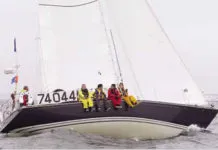

C&C 40 Used Boat Review
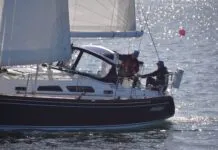
Sabre 386 Used Boat Review
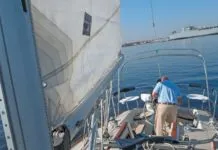
What You Can Learn on a Quick Test Sail

Preparing Yourself for Solo Sailing

Your New Feature-Packed VHF Radio

Preparing A Boat to Sail Solo

Solar Panels: Go Rigid If You have the Space…

Ground Tackle Inspection Tips

Shoe Goo II Excels for Quick Sail Repairs

When Should We Retire Dyneema Stays and Running Rigging?

Rethinking MOB Prevention

An Unusual Sailboat Shines a Light On A Sustainable Future

Is It Time to Get an Electric Dinghy Motor?
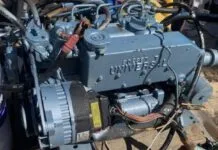
Worship Your Universal M-Series Diesel With the Marinized Kubota Block

Taking Care of Your 12-Volt Lead-Acid Battery Bank

Battle of the Teak Cleaners — Snappy Teak-Nu vs. Star Brite

New Seacocks for the Offshore Sailor

Bottom Paint Care

Quick and Safe Sail Cleaning

Are E-bikes Worth the Extra Weight and Cost?

How to Handle the Head

The Day Sailor’s First-Aid Kit

How to Select Crew for a Passage or Delivery

Re-sealing the Seams on Waterproof Fabrics

Waxing and Polishing Your Boat

Reducing Engine Room Noise

Tricks and Tips to Forming Do-it-yourself Rigging Terminals

Marine Toilet Maintenance Tips

Learning to Live with Plastic Boat Bits
- Sailboat Reviews
Hunter 30: Still the Affordable Fantasy
Production coastal cruiser offers a lot of boat for not a lot of bucks..
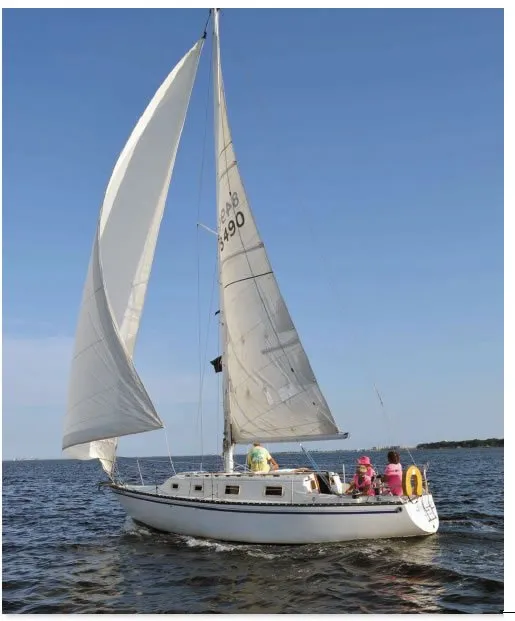
Hunter Marine began building auxiliary sailboats in 1974, largely as the result of the first oil embargo and the new energy consciousness that followed. Founded by Warren Luhrs, Hunter began as a division of the powerboat-maker Silverton Yachts, which was interested in expanding its offerings and taking advantage of the new interest in saving fuel.
The companys aim was high-volume production, keeping prices low by standardizing design, making as few tooling changes as possible, and offering its boats fully equipped-while other companies were selling things like bow pulpits and lifelines as options on a 30-foot boat. The original Hunter boats were marketed as the affordable fantasy and came with sails, dock lines, fenders, life jackets, and fire extinguishers, in what Hunter called the Cruise Pak of standard features. About the only option available on the early Hunters was a choice of shoal- or deep-draft keel.
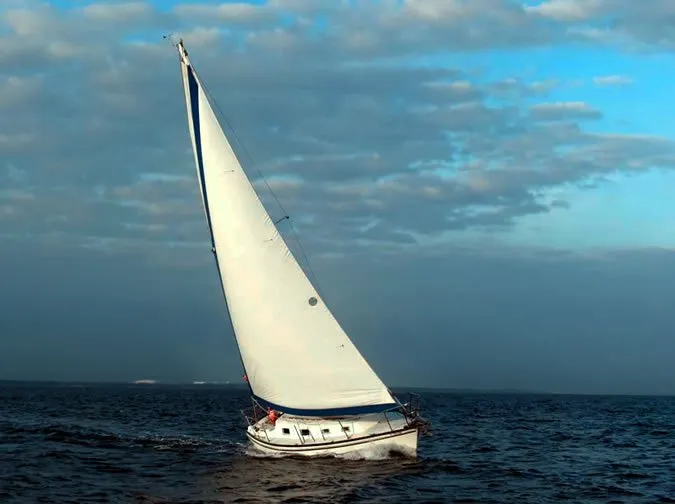
Photo by CeCe Stoldt
In 2012, Hunter Marine was sold to David Marlow, the builder of Marlow Yachts. With this change of ownership came a change in corporate goals and product offerings. Hunter Marine began-like its chief competitor, Catalina Yachts-with a small group of standardized models. From 1974 through 1977, it offered only the Hunter 25, 27, and 30 models, and from 1977 through 1979, the builder added only the 33 and 37. Today, Hunter-Marlow makes nine production models ranging from trailerable daysailors (15 to 22 feet) to mid-size (27 to 37 feet) and large (40 to 50 feet) keelboats.
Also, Hunters high-volume-production business model has been replaced with the Marlow ethos, which is more focused on yacht-level quality than production volume. Marlow-Hunter produces about 100 boats each year, including trailerable and cruising sailboats, as well as Mainship powerboats, according to Greg Emerson, Marlow-Hunters director of sales.
The Hunter 30
Designed by John Cherubini and built from 1974 to 1983, the Hunter 30 is a coastal cruiser that was designed to offer a lot of boat for little money. With a focus on streamlining construction to boost production volume, Hunter aimed to offer an affordable coastal racer-cruiser. More than 1,000 Hunter 30s were built over the nine-year production run; however, a number of them were sold as Quest 30s, which was essentially a sail-away, bare-hull kit boat, and the purchaser completed the interior and the fitting out.
For this report, we checked out a 1980 Hunter 30 (hull #934) and a 1978 model (hull #568). In contrast to later Hunters, the early Cherubini-designed models were conservative and conventional in design. The longer sister models-the 33 and 37-were, in our opinion, good-looking boats, moderately styled, with an attractive bow line and sheer, and a pleasing coachroof. The smaller boats, the 25 and 27, instead traded in some styling characteristics in order to pack a lot of room into a short waterline, which left them with higher-sided with boxier cabinhouses.
The 30 lies somewhere in between-handsome from some angles but a bit too flat in the sheer and high in the cabintop to impress traditionalists. Still, most of those traditionalists would consider it a much more attractive boat than the modern Euro-styled Hunters.
The 30s hull is very full-to maximize interior space-but otherwise, its quite typical of the racer-cruisers of the 1970s. Overall, the boat is 29 feet, 11 inches long-the maximum allowable length under the then-popular Midget Ocean Racing Club (MORC) rule. The short overhangs result in a long waterline, fundamental for sailing speed. The beam, at just a hair over 10 feet, is moderate by 1970s standards, but narrow in comparison to the big 30-footers that have appeared since. The Catalina 30, for example, is nine inches wider, and many current boats carry a foot more beam (and carry it further aft) than the Hunter 30.
A conventional fin keel, drawing 5 feet, 3 inches, was standard, with a 4-foot shoal keel as an option. We test-sailed the deep-keel version, and suspect it is much to be preferred, unless you absolutely need the shallower draft. Company literature lists the displacement and ballast as identical on both models. That would make the shallow-keel version more tender, requiring crew to reef early as the wind pipes up.
The foredeck is on the smaller side for anchor work and sail handling because the cabinhouse extends quite far forward. The 1978 and later models have an anchor well built into the foredeck that is self-contained and large enough to hold over 400 feet of rode, or enough for two anchors. The test boat we sailed had a furling jib, a desirable option in view of the smallish foredeck.
A significant shortcoming of the boats design is the narrow sidedecks. The wide cabinhouse makes it clear that the designers top priority was interior room, with deck work being a distant consideration. Its near impossible to get past the chainplates, especially on the leeward side when under a press of canvas, without climbing atop the cabinhouse.
The boat has a good cockpit, a bit smaller than some other 30-footers (again, a result of maximizing cabin space). A wheel was standard on the boat; its small, which is good for moving around the cockpit, but less than ideal for helming, in our opinion
A T cockpit became standard following the 1980 models, and some people preferred that arrangement; however, you could lie down on the older bench seats, and you can’t with the T. The bench seats would benefit from some sort of drain arrangement since they trap water. A deep lazarette behind the cockpit offers additional on-deck storage.
A peculiarity of the decks on the early Hunters is that the nonskid pattern was not molded in as is customary on fiberglass decks. Instead, a nonskid aggregate was painted on. Given the age of the Hunter 30, the original aggregate is likely long gone, and owners have had to apply fresh nonskid paint or nonskid mat. Fortunately, such a repair is straightforward and an easy (although time-consuming), do-it-yourself project (see PS August 2008 and November 2013 online).
On the boats we examined, there was minimal sail-handling equipment on deck-one pair of jib-sheet winches, a small halyard winch for the jib, no winch for the main halyard, no Cunningham or vang, no control lines on the traveler, no flattening reef, a single jiffy reef block, two jib lead blocks out on the toerail, and no backstay adjuster. However, most H30 owners have added deck gear over the years, including a running backstay, so what youll find on Hunter 30s today will run the gamut. A large number of Hunter 30 owners who responded to our survey reported that their boat was rigged for singlehanding, making it easy to sail with a short- or single-handed crew.
The original Hunter 30 owners manual was a great example of a good, clear, simple manual. It has always amazed us how many other boat builders provide the buyer with little or no printed information. If you happen to own or buy a Hunter 30 (or pretty much any older Hunter model) thats missing its manual, simply download the PDF of the original from the Hunter-Marlow website.
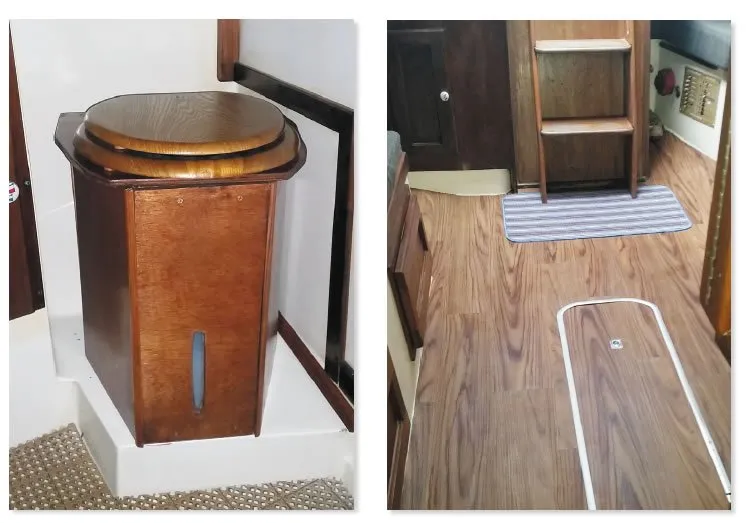
courtesy of Kasi McCain
The 30s interior was a strong selling point for the Hunter 30. Almost every owner that responded to our survey commented on the size of the boats interior-often relative to low price-when talking about their reasons for buying the 30.
The interior is well laid out, but plain. Theres a lot here for the money, however. Some of the original details could use changing-the alcohol stove, lack of vents, and small water tank-and many owners have upgraded or modified these systems.
The Hunter 30s layout is conventional, with a good V-berth forward, then a head with small hanging locker opposite, settee berths on each side of the saloon with a double, a drop-leaf table in the middle, an L-shaped galley, with the sink underneath the companionway, and a quarter berth, with a small chart table at its head. The berths are of good size, and on some boats, the port settee can convert to a double berth.
The head area is roomy with enough space for comfortable showering and a door for privacy. The interior also offers lots of storage for a boat this size: The hanging locker can accommodate plenty of clothes and has an overhead shelf; and there are three large storage lockers in the V-berth, plus a host of drawers and under-seat storage in the saloon.
The icebox on the boat we looked at had minimal insulation and would benefit from several more inches all around. Many owners reported having upgraded with icebox conversion kits.
The deckhouse is high and wide, and this gives a look of spaciousness below. The white hull liner overhead helps offset the extensive teak veneer on the bulkheads, ceilings, sole, and furniture.
There are adequate ports and hatches to allow in enough light. The opening portlights-Hunter was one of the first production boats to offer numerous opening ports as standard-offer good ventilation. If youre considering buying a Hunter 30 that has not had any ventilation upgrades, you will probably want to add some Dorades or solar vents to keep the air moving when the ports and hatches must be closed.
The finish downbelow is typical of low-cost production boats, which depend on pre-fab components that can be rapidly installed in the hull. In our owner surveys, there were a great many complaints about the original joinerwork, door hinges, and hardware. The original cabin sole was made of teak veneer, so in instances of water damage, it often cannot be repaired but must be replaced.

For the first four years of the Hunter 30s production, a 12-horsepower Yanmar diesel was standard. After 1978, standard power was a 15-horsepower Yanmar, followed by an 18-horsepower Yanmar.
The 12 was a particularly noisy engine; the later models were less so. Most of the owners who completed our survey thought the engines were minimal for powering the boat, especially in any kind of head seas; however, by traditional standards, even the 12-horsepower model should be adequate for the weight and length of the boat. Although the 12 is highly praised for its reliability, many people will find the later Hunter 30s to be more desirable because of their larger, smoother-running engines.
Engine accessibility was criticized by almost all of the owners who completed our survey. Access is awful, said one. You must be a left-handed midget to work on this engine.
We thought accessibility was far from ideal, but not excessively bad for this size boat. With a big interior and a small cockpit, its hard to stuff an engine under the cockpit sole without cramping.
The Hunter 30 we sailed (with a Yanmar 12) was well behaved under power; it backed nicely, turned crisply, and drove through strong winds (in protected water) with no problem. Our impression was that the engines vibration and noise were more of a concern than its power. Anyone buying the boat with the Yanmar 12 will probably want to spend the time to get perfect alignment. Wed also look closely at the engine mounts and the shaft-strut mounting.
Some owners have re-powered their boats, usually opting for a Yanmar 2QM15 or Yanmar 2GM20F diesel with good results. A two-blade solid prop was standard, but a number of owners refitted the boat with a three-blade solid prop to improve powering. We doubt if the gain would offset the loss in sailing ability.
Theres a full skeg ahead of the rudder. If you have to remove the propeller shaft for some reason, youll have to remove the engine first, or tear the skeg off. On the shoal-draft version, the skeg also is something of a grounding vulnerability as the rudder is about as deep as the foot of the keel.
We were pleasantly surprised by the sailing performance of the Hunter 30. We sailed one in a long, triangular race-two triangles, then windward-leeward-windward legs-in heavy air, a little over 20 knots at the start.
Considering that the test boat had almost no sail controls and old sails, and that the underbody was rough and a bit weedy, the boat moved very well, going to weather respectably in a serious racing fleet, and reaching and running competitively.
The jib we used was the 130-percent genoa on roller furling, and this was about right for the boat in those conditions. When the wind faded near the end of race, the boat was clearly under-canvassed.
The boat is slightly under-rigged with its short mast. To sail well in light air, especially with the solid prop that most 30s have, a sizeable genoa is required. One Florida Panhandle-based owner reports that she sails with a 155 or 170 genoa, both of which are ideal in light winds and can be reefed with furling if the wind picks up. This boat sails nicely and does better in higher winds than light wind. …. It responds very quickly when tacking and can almost sail itself in steady winds, she explained.
We agree: The 30 is a good sailing boat, responsive and easy to steer. Its PHRF rating of 186 (New England fleet) would probably be very favorable. If the boat were rigged with a full complement of sail-handling gear and modern sails, it should be able to stay with other 30-footers of the same era, such as the Pearson 30, Catalina 30 (not the tall rig), and ODay 30. Since sailing is what sailing is all about, our opinion of the Hunter 30 was improved dramatically when we took a first in the races main-and-jib class.
Conclusions
The Hunter 30 was a boat built to a price point-to appeal to the sailor who wanted a lot of boat at an affordable price.
As long as a buyer understands that, not expecting custom quality at barnyard prices, the Hunter 30 can be a good value in a used boat. Many on the used market today have been repowered and had systems upgrades added like refrigeration. Be sure to look for delamination issues, check the nonskid, and examine the cabinhouse around the mast for sagging, as many of these Hunters have had compression post issues.
Its easy to pay too much for a used boat these days, but for a good-condition, roomy coastal cruiser that can make a good showing around the buoys, the Hunter 30 can be had at a decent price-a lot of cruisability for minimal investment. Youll find Hunter 30s on the used-boat market to be priced about the same as comparable boats (Catalina 30 and Pearson 30), with an average pricetag of about $13,500.
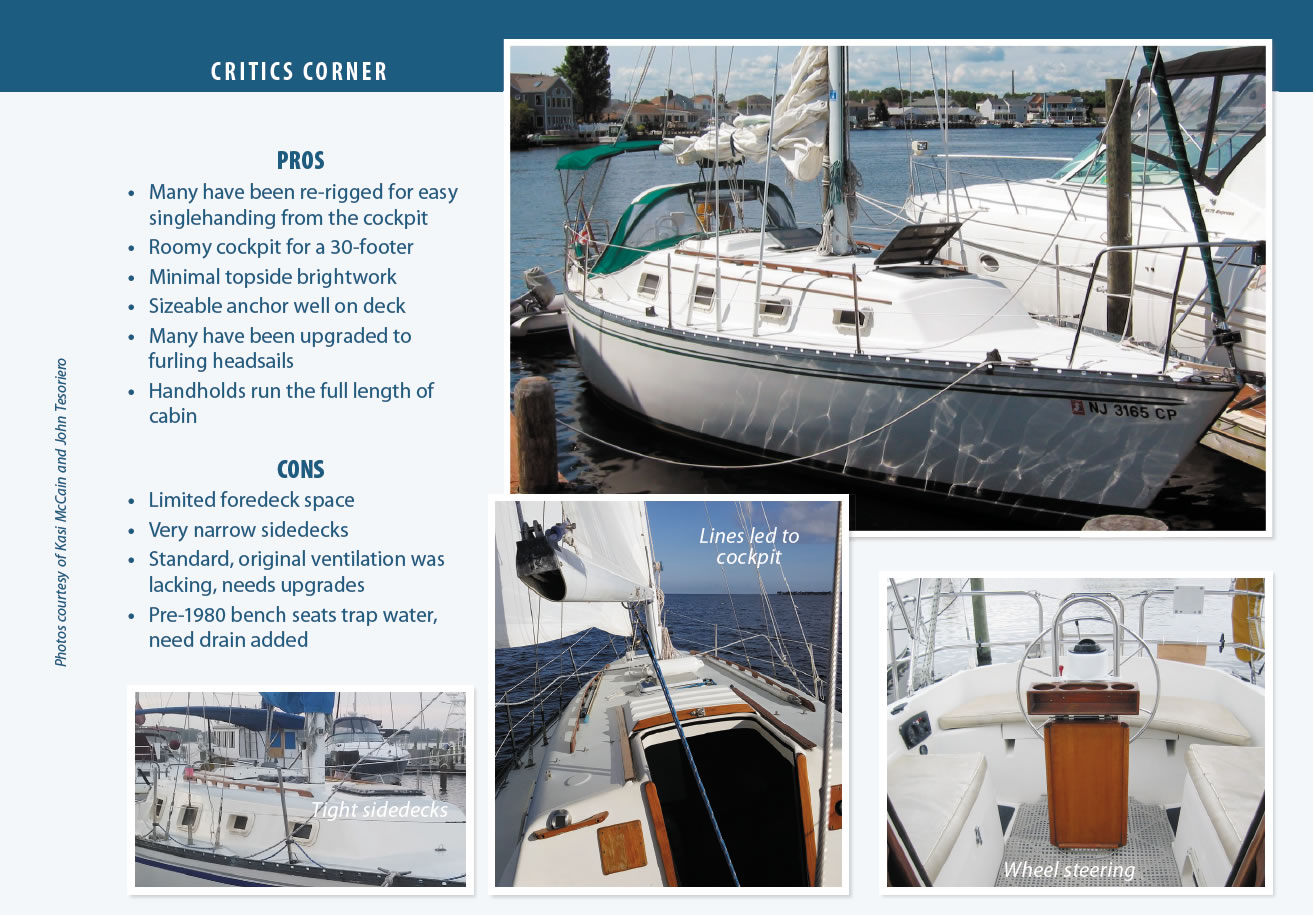
Pros -Many have been re-rigged for easy singlehanding from the cockpit -Roomy cockpit for a 30-footer -Minimal topside brightwork -Sizeable anchor well on deck -Many have been upgraded to furling headsails -Handholds run the full length of cabin
Cons -Limited foredeck space -Very narrow sidedecks -Standard, original ventilation was lacking, needs upgrades -Pre-1980 bench seats trap water, need drain added
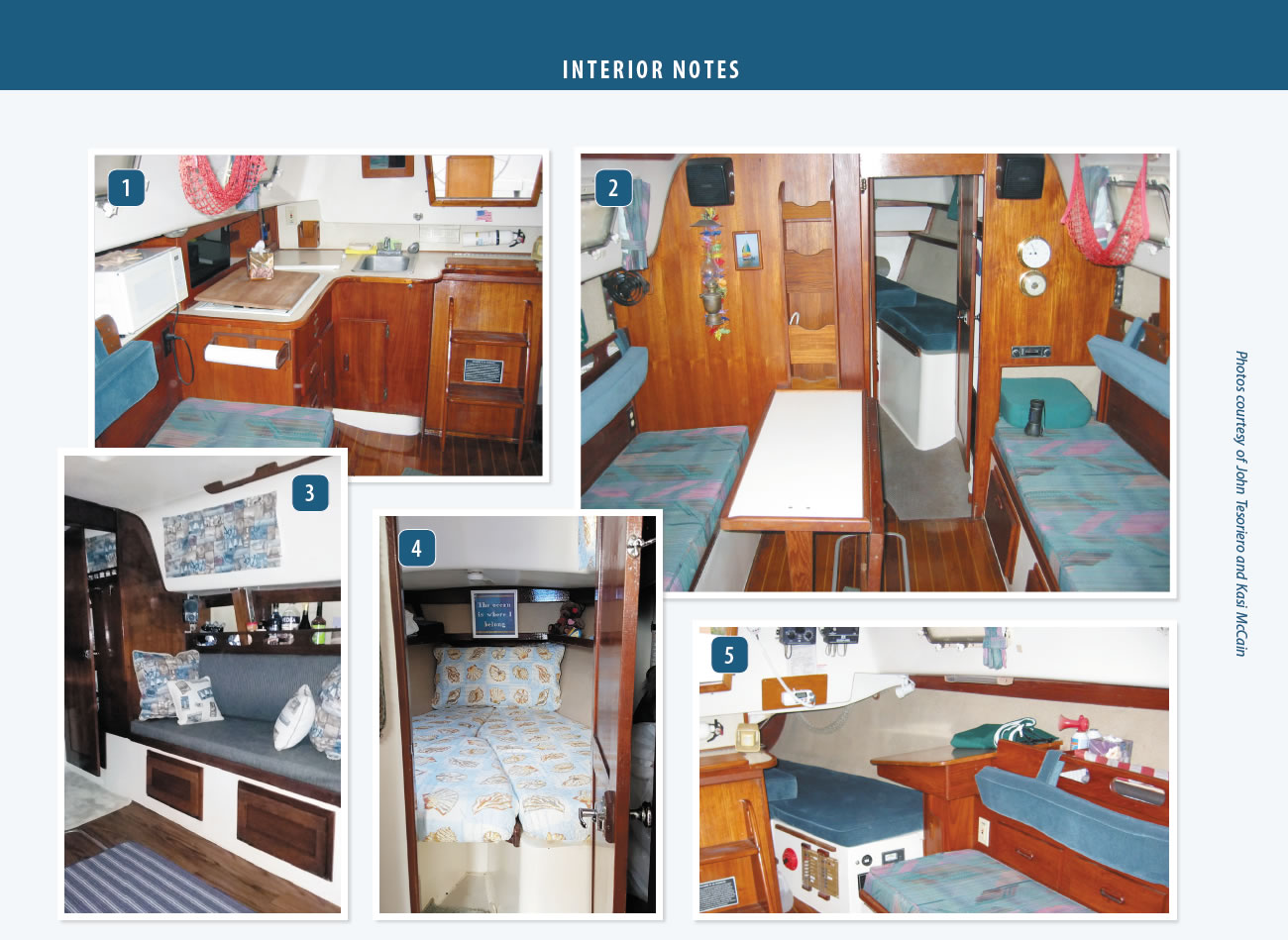
Hunter Marine built the 30 with an aim to maximize interior space. 1. The galley came standard with an alcohol stove, a deep ice box, and a small sink; many owners have updated the cooktop and added some type of refrigeration. The sink is too small to effectively wash dishes. 2. The settees offer full-length berths. 3. The H30 fits a fair bit of interior storage in a small space, including drawers behind and under the settees. 4. The V-berth has additional storage under the bed, which is large enough to comfortably sleep two (friendly) adults. 5. A very small nav desk and a full-length quarter berth are situated to port of the companionway. Electronics can be mounted inside the companionway.
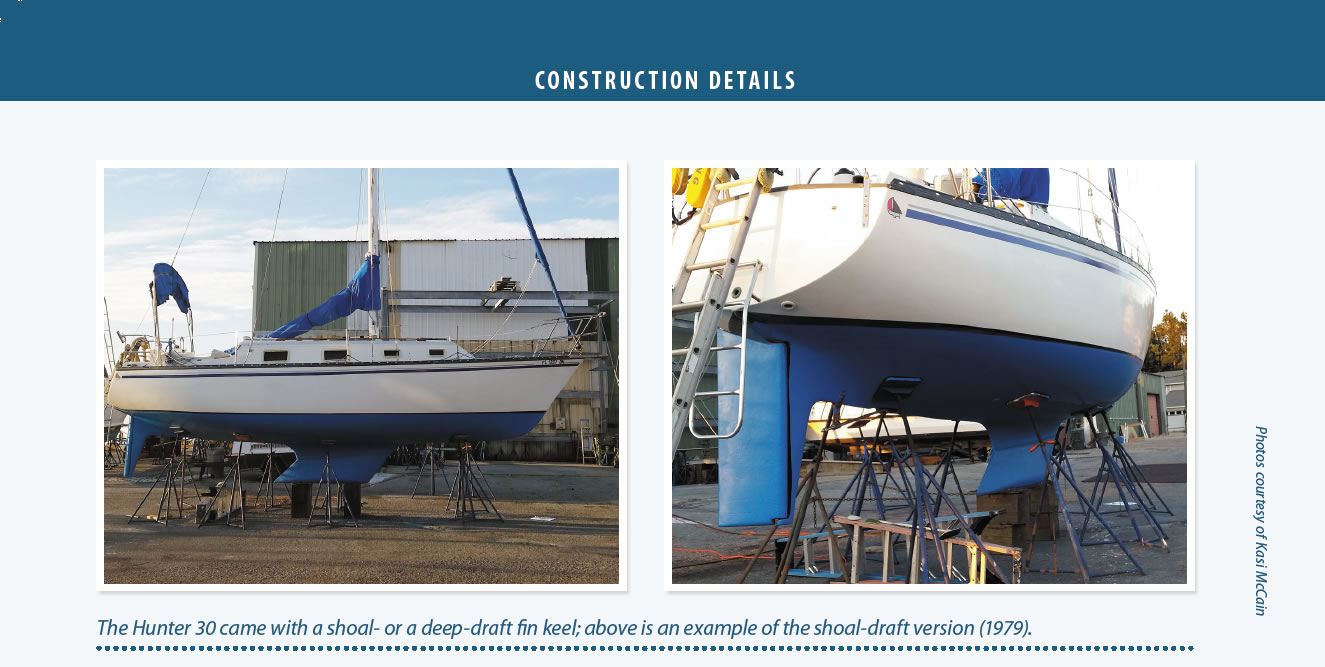
In construction, the Hunter 30 is very conventional—an economical, solid-glass layup in the hull and a balsa-cored deck with plywood for backing under cleats. A conventional flange, with a through-bolted aluminum toerail joins the hull and deck together. The basic construction is quite a contrast to that of present-day Hunters, which can generally be described as highly engineered and Euro-styled, at the opposite end of the spectrum from the early Hunters like the 30.
Testers’ opinion of the fiberglass work was that it was good but a little light—marginal for offshore sailing but strong enough for typical coastal cruising.
On one of the Hunter 30s we looked at, there was extensive delamination of the cockpit sole and the bench seats. There also were signs of sloppy glass work—ragged edges and un-resinated glass—in compartments and other out-of-sight places.
Quality-control problems also were cited by a surprisingly high number of the Hunter 30 owners we surveyed for this article. The problems often mentioned included improperly hooked-up fuel-return lines, chafed hoses, leaking ports, poorly fitted hatch boards and lazarette covers, improperly installed exhaust systems, and so on.
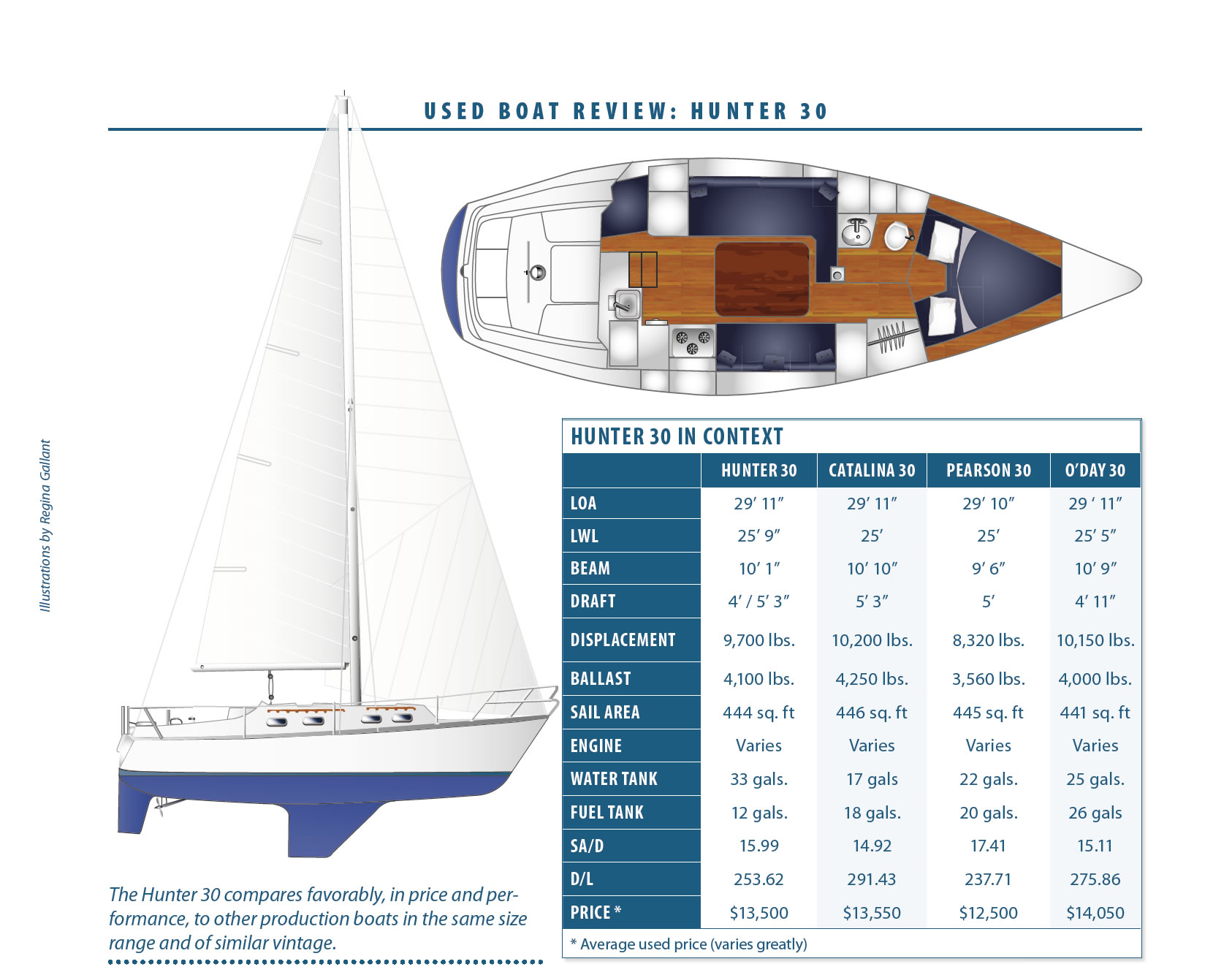
The Hunter 30 compares favorably, in price and performance, to other production boats in the same size range and of similar vintage.
- Marlow-Hunter
- Hunter Owners Group
RELATED ARTICLES MORE FROM AUTHOR
Great review and enlightening! Thanks for your knowledge!
Great coverage on the 30! I owned a Hunter 30 1994-2000. Live aboard at Harbor Island San Diego. Very nice experience. Yes, the Yanmar 15 was a bit noisy. I thought For a while there was mechanical issues but Found out it was it’s nature.
Good article. I bought a 1977 Hunter 30, and it does sail surprisingly well for a older production boat. The engine works okay but is a bit noisy. It will soon be for sail as my daughter is the sailor and moved overseas for college.
Almost 40 years in my 1978 27 ft. Your comments were all on the mark. The original 8 hp gave out after 30 years and repowered with the 15 hp and replace the packing stuffing box with seal. Replaced the ports in the head and vee. For the time available I had to sail it worked out well. Fifteen years on Great Lakes and 22 plus in FL.
LEAVE A REPLY Cancel reply
Log in to leave a comment
Latest Videos

Universal Diesel Engines – What You Should Know

Tayana 37: What You Should Know | Boat Review

Monitor Your Whole Boat From Home On A Mobile App

Beneteau 423: What You Should Know | Boat Review
- Privacy Policy
- Do Not Sell My Personal Information
- Online Account Activation
- Privacy Manager

IMAGES
VIDEO
COMMENTS
Apr 4, 2000. #5. Looks great in my driveway, too. I bought a 170 two seasons ago. I have had great fun sailing it. As others have said, it is stable. Water comes in the transom only if the 170 is not moving, which happens when it's docked, becalmed, or in the driveway as mine is until the docks are put out for the summer.
The Hunter 170 is a joint venture between Hunter Marine and JY sailboats, which combines simplicity and comfort with toughness and performance. The boat and rigging are set up to be as simple as possible, allowing the owner to rig the boat and go sailing very quickly. The mast is light and can be put up by one person, although it's easier with two.
Hunter sailboats are a good boat depending on your needs and what you will be using your boat for primarily. They were designed as a more budget-friendly boat with all of the basic features needed for good coastal cruising. ... Beam: 10.17 ft / 3.10 m; ... Why Do Hunter Sailboats Get Such Bad Reviews? Personal Opinion.
It takes into consideration "reported" sail area, displacement and length at waterline. The higher the number the faster speed prediction for the boat. A cat with a number 0.6 is likely to sail 6kts in 10kts wind, a cat with a number of 0.7 is likely to sail at 7kts in 10kts wind. KSP = (Lwl*SA÷D)^0.5*0.5
So there it is. The 170 is pizza slice that has less wetted surface when heeled, but does not have the foiling appendages or centerboard weight needed for excessive heel. It sails faster with extreme heel but at the expense of control. Loss of control includes rounding up as well as no rudder control and slipping.
Boat Review Forum. SailNet is a forum community dedicated to Sailing enthusiasts. Come join the discussion about sailing, modifications, classifieds, troubleshooting, repairs, reviews, maintenance, and more! Hunter 17 or Hobie Wave. Jump to Latest Follow 16K views ...
the new Hunter 18 replaces the Hunter 170, which for several years was a mainstay in Hunter's line of small daysailers. Like the 170, the 18 can serve as both an easy-to-manage family daysailer and as a lively performance boat for those with more experience. At a glance the two boats look quite similar, sporting open transoms, centerboards and small sprayhoods forward. On closer inspection,
Hunter 170 is a 17′ 1″ / 5.2 m monohull sailboat designed by Hunter Design Team and built by Hunter Marine starting in 1999. Great choice! Your favorites are temporarily saved for this session. Sign in to save them permanently, access them on any device, and receive relevant alerts. ... Hunter 170 is a 17 ...
Practical Sailor is different. Its candor is as sharp as a marlin-spike and its honesty as welcome as a steadfast quartering breeze. And that goes for its acclaimed boat reviews. Over the years, we've reviewed the Hunter 27, 30 and a dozen other Hunter models. For each boat, we take a revealing look at the specifications and construction.
Yet when your sailboat is shorter than 20 feet, you'll usually find it's easier to get underway, easier to handle under sail, and cheaper to buy and maintain. If that sounds like good value to you, take a look at our list of some of the best true daysailers we know of. The Hunter 15 is easy to own, and fun to sail.
The Hunter 170 is a popular sailboat for beginners and experienced sailors alike. In this comprehensive review, we will take a close look at the Hunter 170's features, performance, and overall value.
17' Hunter. 170. 1998. 17'. $ 4,500. An excellent daysailer. The Hunter 170 is a great choice for comfortable sailing either single handed or with up to four adults. A well designed cockpit and generous beam give the H170 the feel of much larger boat while maintaining its ease of sail.
6 posts · Joined 2008. #7 · Aug 29, 2008. I've had a 34 foot '83 Hunter for two years without any real complaint. Most of my issues have been with PO "upgrades". Like some of the other posters have said get a good survey. Like the birds say the nice thing with Hunters is they are cheap, cheap, cheap.
May 17, 2011. The new Hunter 22 is directly derived from its predecessor, the Hunter 216, which was built out of thermoformed Luran-S plastic. The 22 retains the 216's hull, which features a large cockpit and open transom, but is built in fiberglass with a solid bottom section and balsa-cored topsides. The deck, also balsa-cored, has been ...
Aug 21, 2017. Original: Aug 22, 2014. A Big Little Sistership: An able 37-foot cruiser with lots of space and an easy-to-handle rig. The Hunter 37 is effectively a smaller sistership to the Hunter 40, which was introduced in something of a rush in 2012 as Marlow Hunter—formerly Hunter Marine—celebrated its 40th birthday and a change of ...
3. Hunter Marine Corp. is noted for its slick, innovative and low-cost mass production sailers. The Hunter 23.5, new in 1992, fits the bill in all respects. Hunter 23.5 Specs. The 23.5 was designed as a trailerable family cruiser for entry-level sailors. Like most Hunters, the boat offers lots of space in the cockpit and down below, and comes ...
SAIL AREA 386ft2. Fuel/Water/Waste (gal) 15/20/10. ENGINE 14hp Elco AC Electric Engine. Electrical 6 x 210AH. BUILDER Hunter Marine Corp., Alachua, FL, 386-462-3077. Photos courtesy of Hunter Marine. The Hunter 27e just may be the quintessential "new-old boat.". The hull, deck, appendages, rig and interior have been sailing aboard the ...
Sailboat Reviews; Sailboats 21-30ft; used_sailboats; Hunter 27 The Hunter 27 is a boat built to a price--a low price--and it shows; but it may represent a good value. By. Darrell Nicholson - ... Handling Under Sail. The Hunter 27 comes with a mainsail and 110% genoa. The total sail area with this configuration is 360 square feet, an average ...
The Hunter 30. Designed by John Cherubini and built from 1974 to 1983, the Hunter 30 is a coastal cruiser that was designed to offer a lot of boat for little money. With a focus on streamlining construction to boost production volume, Hunter aimed to offer an affordable coastal racer-cruiser.
Hunter Marine, 386-462-3007, www. huntermarine.com Bill Springer. Not so long ago, compact coastal cruisers usually provided cramped quarters and minimal comfort, but the new Hunter 27 is cut from an entirely different mold. It s only 27 feet long, but its 6 feet, 2 inches of headroom and nearly 10 feet of beam provide enough internal volume ...